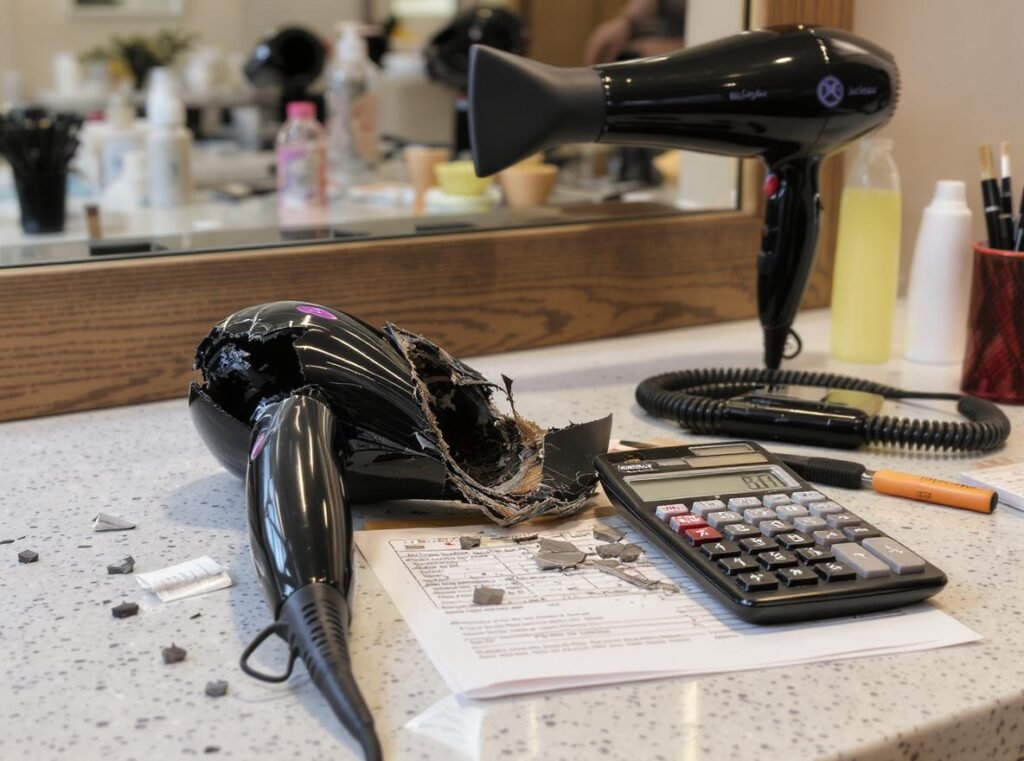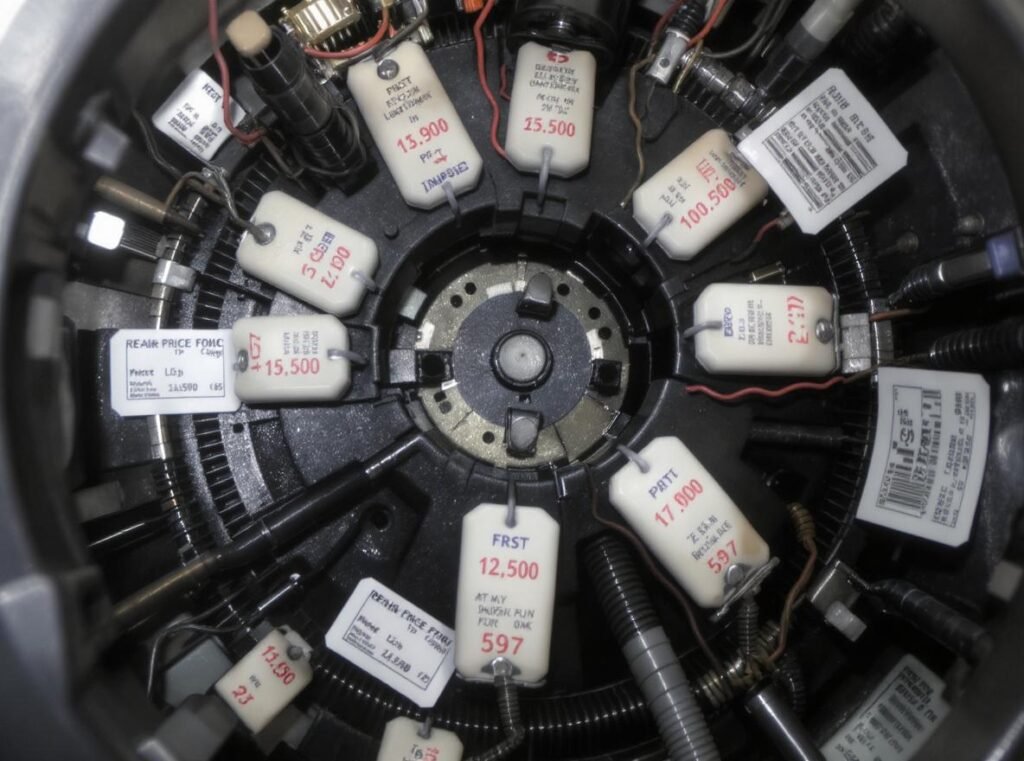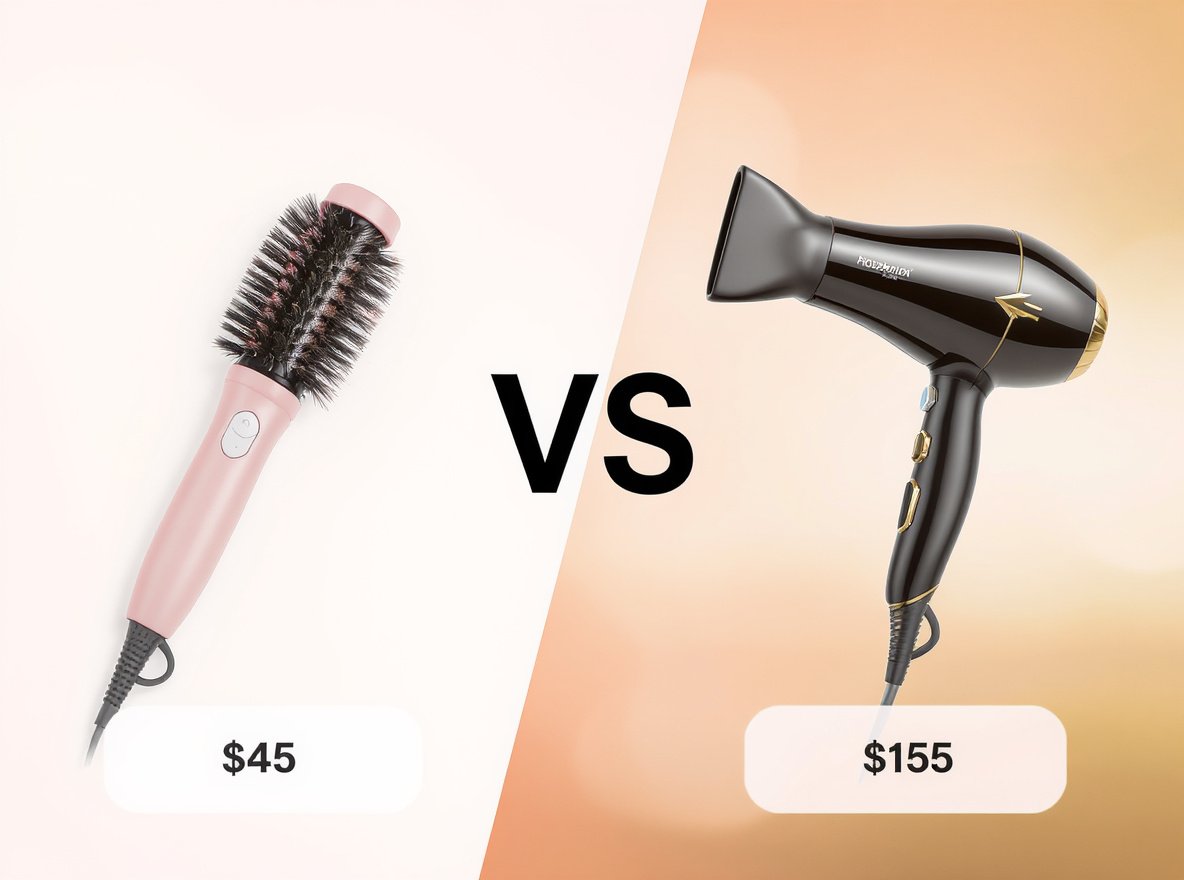Your salon’s premium hair dryer breaks during peak hours, or your wholesale inventory includes units needing repairs. You face a critical business decision: invest in professional repair services or replace the equipment entirely?
Hair dryer repair services cost $48-$300 but rarely justify the expense. With basic replacements available for $20-$50 wholesale and professional units under $200, repairs typically exceed 50% of replacement value—making new equipment the smarter business investment.
Understanding the true economics of hair dryer repairs helps you make profitable decisions for your business operations.
Table of Contents
ToggleWhat Factors Determine Hair Dryer Repair Costs?
Professional repair pricing varies significantly based on service type, equipment complexity, and geographic location.
Hair dryer repair costs range from $48-$300 depending on the problem complexity, brand requirements, and service provider. Professional services charge flat rates starting at $48 for basic repairs, while complex commercial equipment repairs can reach $300.
Professional Service Pricing Structure
Repair services typically operate on flat-rate or hourly billing models:
Flat-Rate Services:
- Sam Villa Repair Service Center: $48 including parts and shipping
- Commercial salon services: $20-$50 for standard repairs
- Premium brand specialists: $100-$200 per repair
Hourly Rate Services:
- Diagnostic fees: $50-$100 initial assessment
- Labor rates: $50-$125 per hour
- Service call minimums: $70-$130 even for simple issues
| Service Type | Cost Range | Typical Turnaround | Success Rate |
|---|---|---|---|
| Basic Consumer Repair | $48-$80 | 5-7 days | 85% |
| Professional Equipment | $100-$200 | 7-14 days | 75% |
| Specialty/Vintage Models | $150-$300 | 14-21 days | 60% |
Brand and Model Impact on Costs
High-end manufacturers often require specialized service centers with premium pricing. Dyson Supersonic repairs through authorized centers can cost $100-$200, approaching 50% of the original $400 purchase price.
Generic and mid-tier brands typically offer more affordable repair options, but parts availability becomes a significant concern for models over 3-5 years old.
When Does Hair Dryer Repair Make Financial Sense?
The standard appliance repair guideline applies: repairs should cost less than 50% of replacement value to justify the investment.
Hair dryer repairs only make financial sense for professional equipment over $200 or premium consumer models over $300 that are less than 3 years old. Most consumer and basic commercial units fail this cost-benefit analysis.
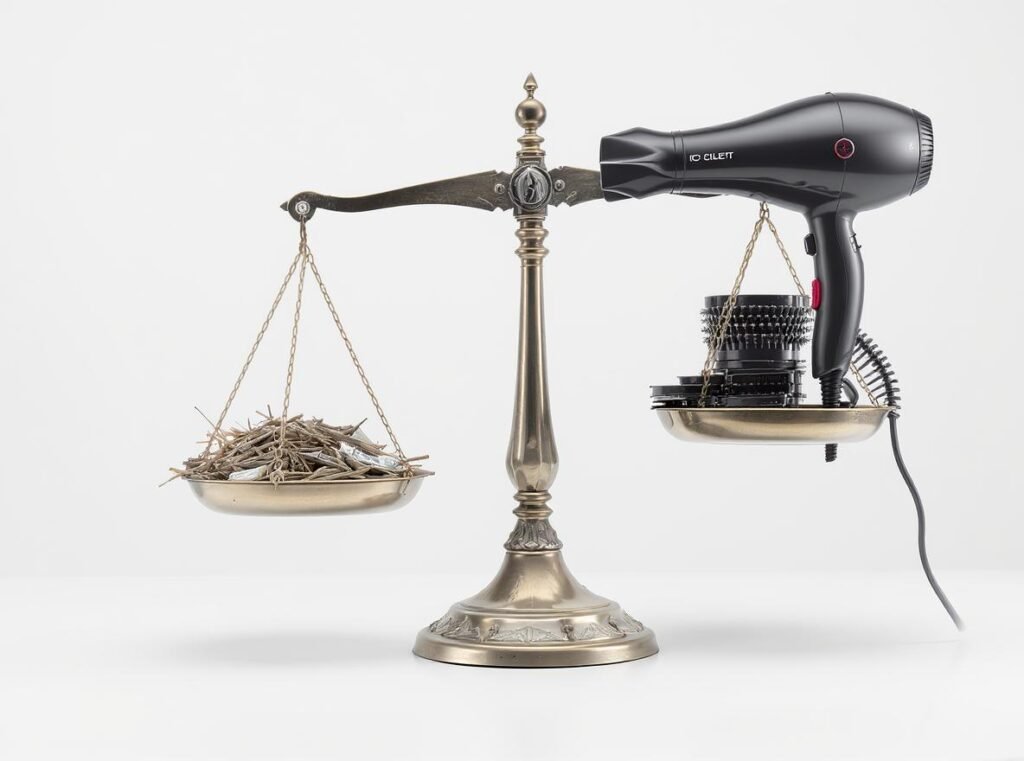
The 50% Rule Applied to Hair Dryers
Financial viability depends on your equipment category and usage requirements:
Consumer Market Analysis:
- Basic models ($20-$50): Repair never justified at $48+ cost
- Mid-range units ($50-$150): Marginal cases only for newer models
- Premium consumer ($300+): Potentially viable if under warranty period
Professional Equipment Analysis:
- Wall-mounted salon dryers ($200-$800): Often justify repairs
- Commercial hooded units ($1,000-$3,000): Usually cost-effective to repair
- Specialized professional tools: Consider replacement cycle and availability
Business Continuity Factors
Professional salons face unique considerations beyond pure cost analysis:
- Downtime costs: 5-14 days without equipment affects revenue
- Customer satisfaction: Equipment failures disrupt service quality
- Insurance considerations: Some policies require professional repairs
- Matching requirements: Consistency across multiple locations
What Are the Hidden Costs of Hair Dryer Repairs?
Repair expenses extend far beyond the quoted service price, particularly for business operations.
Hidden repair costs include shipping ($15-30), downtime revenue loss ($150-3000 for salons), diagnostic failures, and repeat service needs. These factors can double your effective repair investment compared to initial quotes.
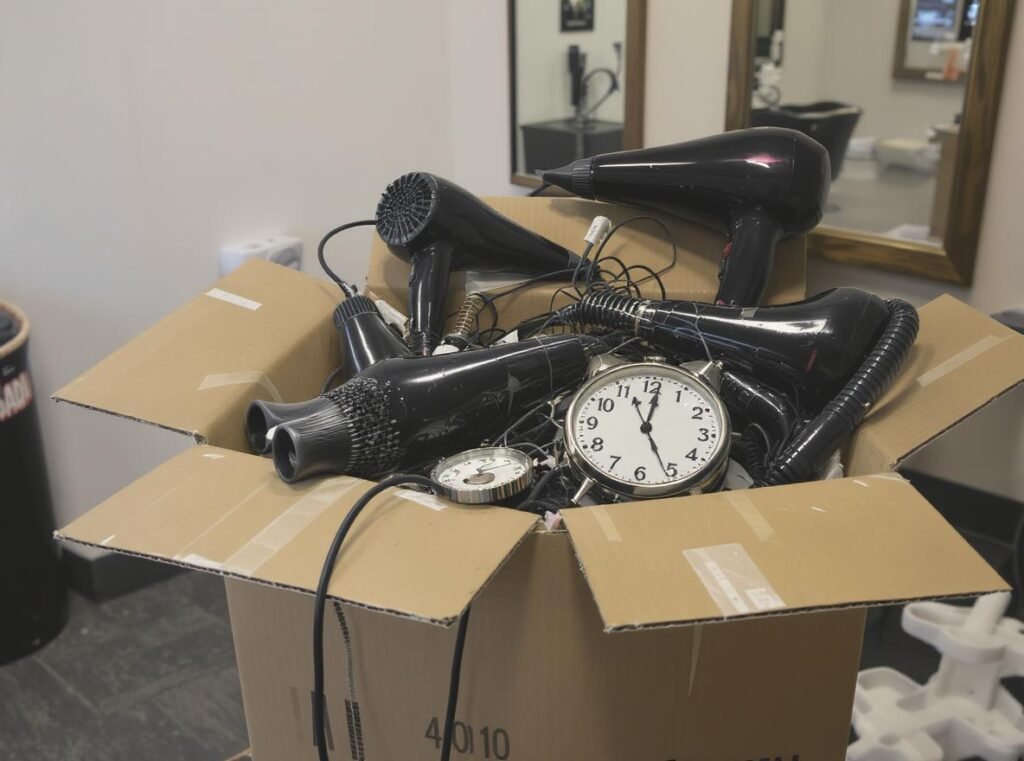
Operational Downtime Impact
Business disruption creates measurable financial losses:
Salon Revenue Impact:
- Hair stations: $150-300 daily revenue per station
- Typical repair downtime: 5-10 business days
- Lost revenue range: $750-3,000 per repair
Hotel/Resort Operations:
- Guest room amenities: $50-100 daily impact per room
- Repair timeframe: 3-7 days
- Revenue loss: $150-700 per unit
Shipping and Logistics Costs
Mail-in repair services involve several additional expenses:
- Round-trip shipping: $15-30 depending on carrier and insurance
- Packaging materials and handling time
- Risk of damage or loss during transit
- Coordination time for pickup and delivery scheduling
| Cost Category | Amount Range | Business Impact |
|---|---|---|
| Direct shipping | $15-30 | Low |
| Staff coordination time | $25-50 | Medium |
| Revenue loss (downtime) | $150-3000 | High |
| Replacement unit rental | $50-100 | Medium |
Reliability and Warranty Limitations
Repaired hair dryers typically carry 30-90 day warranties, significantly shorter than new equipment warranties of 1-3 years. This limited coverage creates ongoing risk for businesses requiring consistent equipment performance.
Consumer reports indicate repaired units frequently develop new issues within 6-24 months, particularly for models exceeding their typical 2-5 year design lifespan.
How Do Repair Costs Compare to Replacement Options?
Modern hair dryer pricing makes replacement increasingly attractive compared to repair investments.
New quality hair dryers cost $20-$200 retail, while wholesale prices range $6-$89 per unit. When repairs cost $48-$300, replacement provides better value through improved efficiency, full warranties, and current technology features.
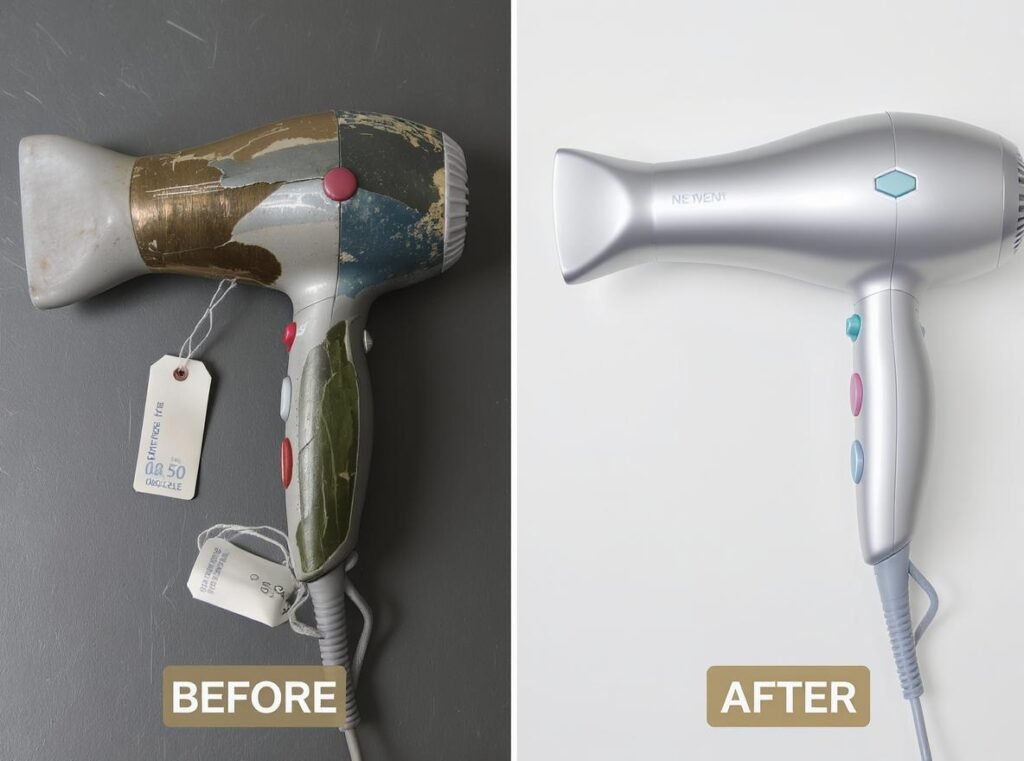
Wholesale Market Pricing
Business buyers access significantly lower replacement costs:
Wholesale Hair Dryer Pricing:
- Basic consumer models: $6-20 per unit (1000+ quantity)
- Professional salon units: $37-89 per unit (minimum 100 pieces)
- Premium commercial equipment: $150-300 per unit
Retail Comparison Pricing:
- Basic replacement models: $20-50 retail
- Professional-grade units: $100-400 retail
- Premium consumer brands: $300-600 retail
Total Cost of Ownership Analysis
Smart business decisions require evaluating long-term costs rather than upfront expenses:
5-Year Repair Scenario:
- Initial repair cost: $150
- Higher energy consumption: $30/year additional
- Likely second repair: $120
- Limited warranty protection after 90 days
- Total cost: $420
5-Year Replacement Scenario:
- New professional unit: $180 wholesale
- Energy-efficient operation: baseline costs
- Full 2-year warranty coverage
- Modern features increase productivity
- Total cost: $180
Technology and Efficiency Improvements
Modern hair dryers offer significant advantages over repaired older models:
- Energy efficiency: 20-30% lower electricity consumption
- Performance improvements: Faster drying reduces service time
- Safety features: Updated thermal protection and cord design
- Ionic technology: Better hair health and customer satisfaction
What Should Wholesalers and Retailers Consider?
Business customers face unique factors affecting repair versus replacement decisions beyond simple cost calculations.
Wholesalers and retailers should prioritize inventory consistency, customer satisfaction, and liability management over short-term repair savings. New equipment prevents customer complaints, reduces return rates, and eliminates warranty complications.
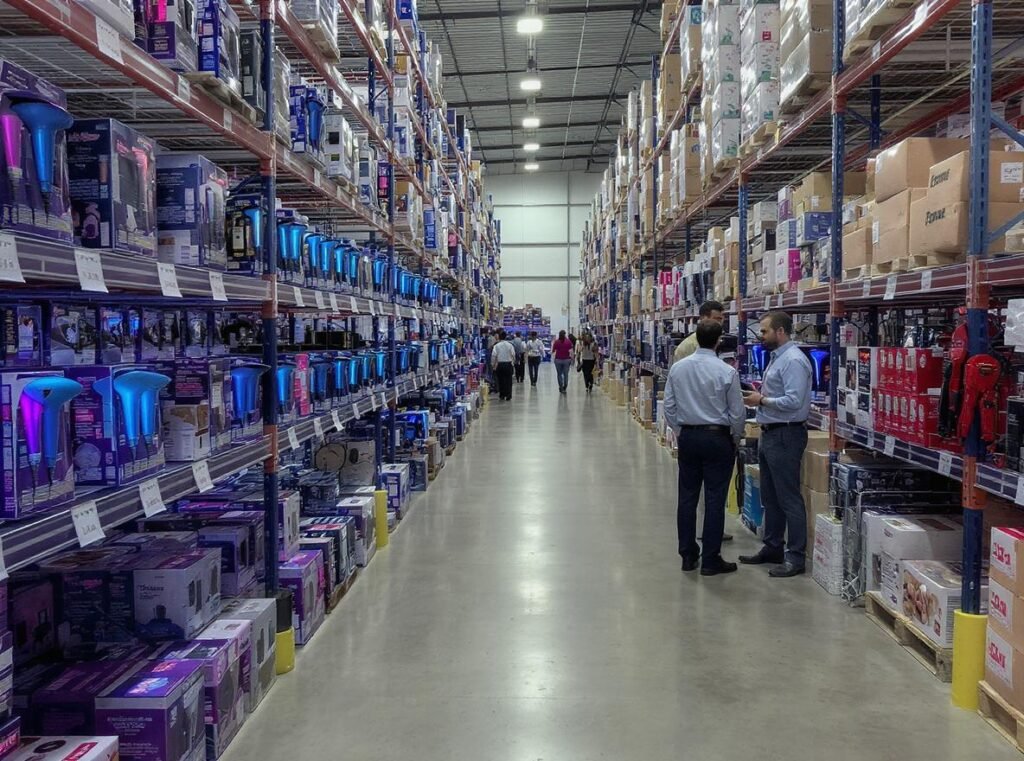
Customer Service and Return Rate Impact
Selling repaired hair dryers creates measurable business risks:
Customer Satisfaction Metrics:
- New equipment satisfaction: 90-95%
- Repaired unit satisfaction: 60-70%
- Return rates: 3-8% new vs. 15-25% repaired
- Warranty claim complications from previous repairs
Brand Reputation Considerations:
- Customer expectations for unused products
- Negative reviews from equipment failures
- Difficulty explaining repair histories to end users
- Competition advantages from offering only new inventory
Inventory Management Benefits
Maintaining consistent new inventory provides operational advantages:
Operational Efficiencies:
- Uniform product specifications across all units
- Simplified staff training on features and warranties
- Predictable performance characteristics
- Streamlined supplier relationships through consistent ordering
Financial Benefits:
- Volume purchasing discounts on new equipment
- Reduced handling costs for mixed inventory
- Simplified warranty and return processing
- Better cash flow predictability
| Factor | Repaired Inventory | New Inventory | Business Priority |
|---|---|---|---|
| Customer satisfaction | 60-70% | 90-95% | Critical |
| Return processing | Complex | Standard | High |
| Staff training needs | High | Low | Medium |
| Supplier relationships | Complicated | Streamlined | High |
Professional Market Opportunities
The professional salon market represents the primary segment where repair services add value:
- Equipment costs justify repair investments ($200-$3,000 range)
- Business continuity requirements during repair periods
- Specialized features not available in consumer replacements
- Long-term client relationships supporting premium service
For wholesalers targeting this segment, offering expedited repair services or loaner programs can create competitive advantages.
Are DIY Hair Dryer Repairs Worth Attempting?
Some businesses consider self-repair to reduce costs and eliminate service delays.
DIY hair dryer repairs work for simple maintenance issues like filter cleaning and thermal fuse replacement, but complex problems risk safety hazards and void warranties. Most businesses should avoid DIY repairs due to liability concerns and limited success rates.

Simple DIY-Friendly Repairs
Certain maintenance tasks can be performed safely in-house:
Low-Risk DIY Repairs:
- Air filter cleaning and replacement
- Debris removal from intake vents
- Loose screw tightening on housing
- Power cord inspection and basic cleaning
Moderate-Risk Repairs (with electrical experience):
- Thermal fuse replacement ($5-15 parts cost)
- Basic switch replacement ($10-25 parts cost)
- Simple cord replacement with proper tools
Professional-Only Repair Requirements
Complex repairs require specialized expertise and equipment:
High-Risk Repairs Requiring Professional Service:
- Motor replacement and calibration
- Heating element repair and insulation
- Internal wiring modifications
- Electronic control system diagnosis
Professional service ensures proper repair techniques, safety compliance, and preservation of any remaining warranty coverage.
Business Liability Considerations
Self-repair attempts create significant risks for commercial operations:
- Fire hazards from improper electrical connections
- Electric shock dangers to employees and customers
- Insurance complications if self-repaired equipment causes incidents
- Regulatory compliance issues with electrical safety standards
Professional repairs or certified new equipment eliminates these liability concerns while ensuring compliance with commercial safety requirements.
What Are the Best Alternatives to Hair Dryer Repair?
Smart businesses explore multiple strategies beyond traditional repair services for equipment management.
The most effective alternatives include warranty replacement claims, bulk purchasing programs, preventive replacement schedules, and upgrading to commercial-grade equipment like the Conason P1C for superior reliability and performance.
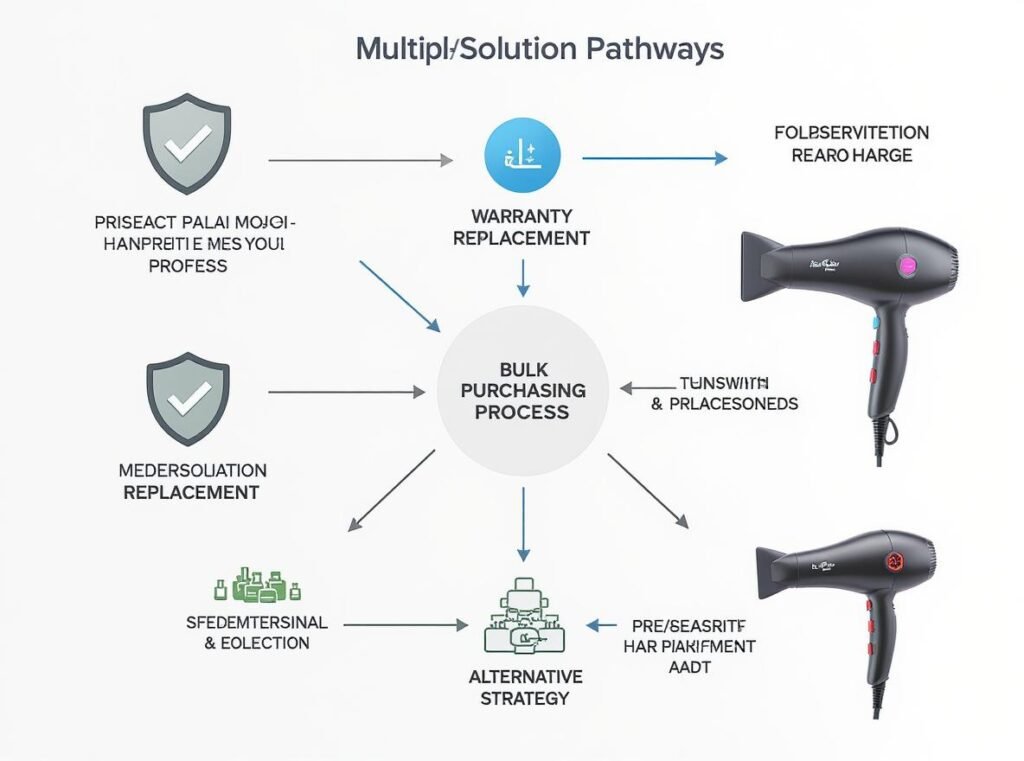
Manufacturer Warranty Strategies
Many equipment failures occur within warranty periods, making manufacturer replacement the most cost-effective solution:
Warranty Optimization Practices:
- Document all purchase dates and maintain receipts
- Understand warranty terms and coverage limitations
- Register products promptly for extended coverage
- Track warranty status across equipment inventory
Quality manufacturers like Conason provide comprehensive warranty coverage that eliminates repair costs during the protection period, often 1-3 years for professional equipment.
Strategic Bulk Purchasing
Volume equipment purchasing provides significant cost advantages over individual repairs:
Bulk Purchase Benefits:
- Volume discounts: 20-40% savings over retail pricing
- Inventory backup preventing operational disruptions
- Consistent specifications across all equipment
- Simplified maintenance with identical units
Recommended Purchasing Strategy:
- Replace multiple units simultaneously to capture volume pricing
- Maintain 10-20% backup inventory for immediate replacement
- Negotiate service agreements with equipment suppliers
- Consider annual equipment refresh programs
Professional Equipment Leasing
Equipment leasing programs offer advantages for multi-location businesses:
Leasing Program Benefits:
- Predictable monthly costs replacing unpredictable repair expenses
- Automatic equipment replacement for failed units
- Tax advantages from operational versus capital expenses
- Built-in technology upgrade cycles
Lease vs. Purchase Analysis:
- Monthly lease costs: $15-50 per professional unit
- Maintenance and replacement included in agreements
- Technology refresh every 2-3 years automatically
- Reduced capital investment requirements
How Can Businesses Prevent Hair Dryer Failures?
Preventive maintenance significantly extends equipment lifespan while reducing unexpected repair needs.
Regular cleaning, proper storage, user training, and environmental controls prevent 70% of common hair dryer failures. Implementing systematic maintenance programs costs far less than repairs while improving equipment reliability.
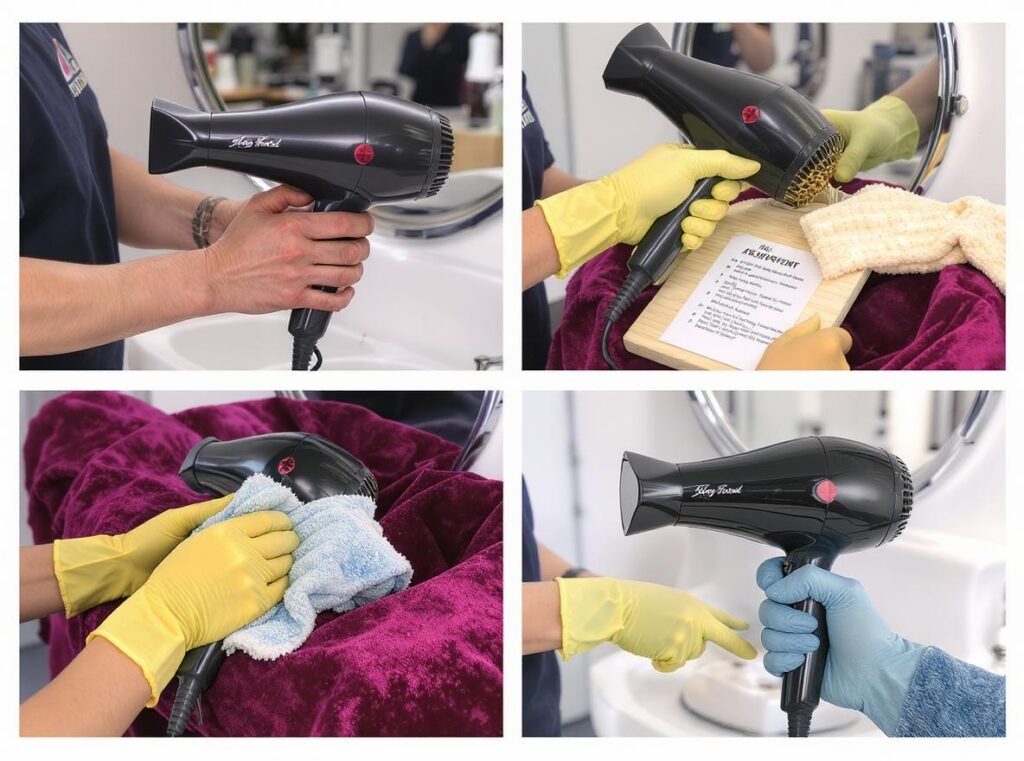
Daily Maintenance Protocols
Consistent daily care prevents most equipment problems:
Essential Daily Tasks:
- Clean lint and debris from air intake vents after each use
- Inspect power cords for damage, wear, or loose connections
- Wipe exterior surfaces to prevent product buildup
- Store in designated dry locations away from humidity
Staff Training Requirements:
- Proper handling techniques preventing drops and impacts
- Appropriate heat settings for different applications
- Recognition of warning signs indicating potential problems
- Correct storage methods preventing cord damage
Weekly and Monthly Maintenance
Deeper maintenance tasks require scheduled attention:
Weekly Maintenance Checklist:
- Deep clean internal components with compressed air
- Test all switches, heat settings, and speed controls
- Inspect heating elements for discoloration or damage
- Verify proper airflow through all ventilation areas
Monthly Professional Tasks:
- Complete performance evaluation and documentation
- Internal component inspection and cleaning
- Electrical connection verification and tightening
- Replacement of filters and worn components
| Maintenance Level | Frequency | Time Investment | Failure Prevention |
|---|---|---|---|
| Basic cleaning | Daily | 2-3 minutes | 40% |
| Deep maintenance | Weekly | 15-20 minutes | 25% |
| Professional service | Monthly | 30-45 minutes | 30% |
Environmental and Usage Controls
Operating conditions significantly impact equipment longevity:
Environmental Management:
- Humidity control preventing internal corrosion
- Temperature regulation reducing thermal stress
- Voltage stabilization protecting electrical components
- Dust filtration keeping internal mechanisms clean
Usage Optimization:
- Rotation schedules preventing overuse of individual units
- Load balancing across multiple pieces of equipment
- Proper cooling periods between intensive use sessions
- Regular performance monitoring and trend analysis
Strategic Equipment Replacement Planning
Proactive replacement prevents unexpected failures during critical periods:
Replacement Planning Guidelines:
- Budget 15-20% of equipment value annually for replacement
- Track usage hours and performance degradation
- Replace professional units every 4-5 years regardless of condition
- Maintain backup inventory for immediate deployment
The Conason P1C professional hair dryer exemplifies equipment designed for extended commercial use, featuring advanced ionic technology, multiple heat settings, and construction specifically engineered for high-volume salon environments.
Summary
Hair dryer repair services provide limited value for most business applications. With repair costs of $48-$300 and quality replacement options available for $20-$200, repairs rarely meet the 50% cost threshold for financial viability. Modern equipment like the Conason P1C offers superior performance, energy efficiency, and reliability compared to repaired older models, making new purchases the smarter long-term investment.
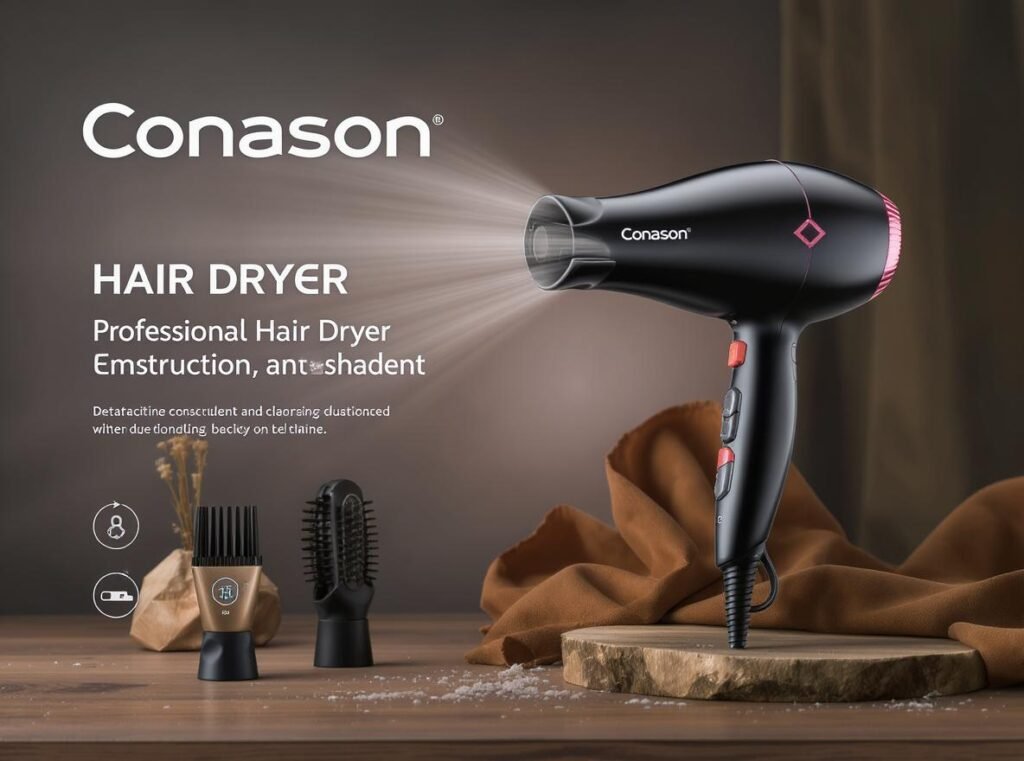
Ready to upgrade your hair dryer inventory with reliable, professional-grade equipment? Explore our complete collection of high-performance hair dryers or discover the advanced features of our popular P1C model. Contact our wholesale team today for volume pricing and dealer programs tailored to your business needs.

